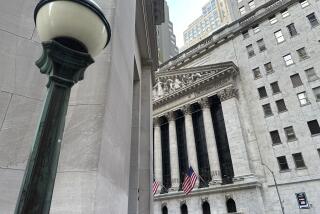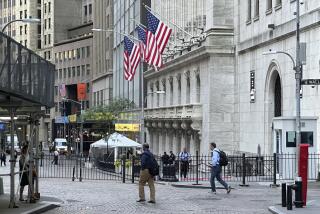Bond Buyers Are Jumpy, and Yields Move Likewise : Investments: Concerns about inflation have mixed with worries about a Japanese withdrawal from the Treasury market.
- Share via
NEW YORK — The people who oversee the flow of billions through the markets earn their keep putting up with uncertainty. But sometimes the market’s mysteries become too much even for them, and they head for the exits.
That’s roughly what’s been happening in the bond market in recent weeks. Concerns about inflation have mixed with worries about a Japanese withdrawal from the Treasury-bond market, the unforeseen costs of the thrift bailout and other fears, driving some professional bond buyers from the action.
Their pullback has caused bond yields to edge upward. Last week, the yield on the benchmark 30-year Treasury bonds exceeded 9% for the first time in a year. That’s was a substantial increase of about half a percentage point in just the past month.
Another sign of the bond buyers’ nervousness was the full 1-percentage-point spread between yields on short-term and long-term Treasury bonds. The spread was investors’ way of saying they needed to be paid more for the risk that inflation would erode some of their long-term investment.
“It takes a certain amount of guts to face a market like this,” said Kevin Logan, chief economist at the New York office of Swiss Bank Corp. “Right now, there aren’t too many guys out there who want to be brave.”
The high rates have been greeted warmly by some individual investors, who have been buying bonds with a fervor not seen in some time.
But the situation is giving the willies to institutional investors, who have worried that prices would slide further before they got around to selling.
Treasury bond yields are benchmarks for a wide variety of other interest rates, so rising rates portend bad news for some sectors of the economy.
The auto and housing sectors, for example, are already weak. They could suffer even more if rates rise further.
The biggest blow to the traders’ confidence was a recent report on the consumer price index, which suggested that prices were rising quickly but didn’t entirely explain why, Logan said.
CPI numbers that came out April 17 showed that even when volatile food and energy components were stripped away, inflation was 0.7% in March. That came as a shock to the many investors who were looking for a rise of about 0.2%.
For the first quarter, inflation--less food and energy components--was rising at a 7.5% rate. “That just jumped out from behind a rock, and nobody quite knew why it was there,” Logan said.
For much of last week, bond traders were looking with apprehension toward Friday’s release of government statistics that would show more about inflation and quantify the first-quarter rise of the gross national product.
The bond market survived that report without a crisis, but perhaps only because it had hunkered down, expecting the worst.
The figures showed that the quarterly GNP was up 2.1%, twice the previous quarter’s rate but substantially short of the 2.5% to 2.7% some analysts were expecting. The news was somewhat comforting, since a slower growth rate presumably means there will be less bidding up of prices.
The inflation figures that came with Friday’s government report were less reassuring. By an inflation gauge called the GNP deflator, prices were up 6.7% for the first quarter, compared to 4.5% a year earlier.
Many analysts believe that the rise in long-term rates, by signaling the market’s inflation anxieties, puts additional pressure on the Federal Reserve Board to hike rates.
While the central bank isn’t panicked as easily as the markets, some contend that a failure to raise rates to brake inflation would hurt the Fed’s credibility and lessen its ability to control inflation in the future.
“I think they’re under considerable pressure here,” said Roger Craig, portfolio manager at Banc One Asset Management in Columbus, Ohio. He predicted that yields on the 30-year Treasury bond might drift up somewhat further, to as much as 9.25%, over the next several weeks.
Robert Dederick, chief economist with Northern Trust Bank in Chicago, noted that two of the 11 members of the Fed committee that has primary responsibility for credit have recently spoken in favor of a tightening.
But he pointed out that Fed members, like some economists, might interpret the mixed signals coming from the economy to mean that inflation may abate as the year goes on.
Dederick said the GNP figures were distorted by a “series of quirks,” such as the effects of last year’s Boeing strike, which made this year’s figures look stronger, as well as December’s sharply colder weather and auto company sales incentives that began in December.
The rise in bond yields has “certainly put the issue of a rate hike on the table (for the Fed). But I’d want to see more evidence,” Dederick said.
Many analysts expect the bond market to remain spooked over the next several weeks for several reasons.
Some investors are worried by the prospect that the Japanese won’t be as eager to participate in next month’s $30-billion Treasury refinancing as they have in the past. There’s anxiety, too, over a government report on employment due Friday.
But some assert that the worries are baseless. John D. Connolly, an analyst with Dean Witter, says the Japanese haven’t been such big buyers at the Treasury bond auctions after all.
Last year, they bought a net $2.4 billion in Treasuries. The top foreign buyers, the British, bought a net $20.2 billion.
Connolly maintains that the absence of huge sales of high-yield certificates of deposit by thrifts suggests that there aren’t a lot of S&Ls; out there with dire but hidden problems.
On inflation, Connolly is reassured by the stable growth in wages, which are advancing at a year-to-year rate of 4%.
“The trouble in bond-land is exaggerated,” he says.
More to Read
Inside the business of entertainment
The Wide Shot brings you news, analysis and insights on everything from streaming wars to production — and what it all means for the future.
You may occasionally receive promotional content from the Los Angeles Times.











